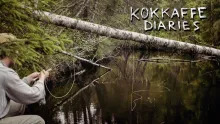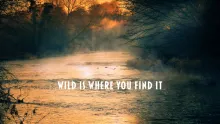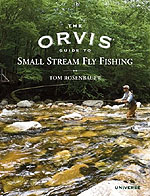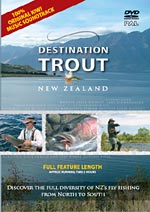In this article I will give an in depth explanation to why people fly half way around the earth to fish for trout. Besides that I will offer advice to people who have speculated about going there on a fishing adventure. The reasons why New Zealand is considered the prime destination when it comes to trout fishing are many...

Another one bites the grass before a careful release.

A guide is worth his wages if you want to learn the art of stalking trout

The gin clear waters and large fish so typical for New Zealand

It might seem barren, but the clear, fast running water holds some huge fish.

The valleys of the South Island are like a fairy tale

A surprise from a South Island river. A nice rainbow which couldn't refuse a dry fly.

The author with a respectable New Zealand brownie. A size 16 Pheasent Tail nymph did the trick.

A fish like this makes the trip "Down Under" worthwhile.

Here is looking at you kid!

The stripes on this photo are the results of diping my camera in the river.

Catch and release is not a a must, but who wants to eat fish every day?

Getting a large South Island fish out of the net.

A Weta grasshopper and a bad imitation of it, the nymph on the left of my hand is a size 16.

Dragonfly or Helicopter?

With insects as big as above, no wonder the fish can get this big.

A mad brownie that threw itself over my Hopper imitation, as you can see, it did not even take the time to open it's mouth.

Fishing for trophy brownies in a small tarn. Imagine casting a size 18 nymph to a brown trout with an weight arround 12 lbs. Scary?

Wading bare legged is the New Zealand style.

A north island brownie, caught just outside "The trout capital of the world" or Turangi on the banks of lake Taupo.
Photos: Andreas Lundkvist, Peter Hansson, René Palmér
Every year you read a lot of articles about the fishing in New Zealand. It's said to be the world's finest. The question is: why is it considered best right there?
In this article I will give an in depth explanation to why people fly half way around the earth to fish for trout. Besides that I will offer advice to people who have speculated about going there on a fishing adventure.
The reasons why New Zealand is considered the prime destination when it comes to trout fishing are many...
Climate
The best season is between December and March - the New Zealand summer. The temperature will vary depending on which island you are on, but usually the day temperatures are between 23 and 35 deg. C in the shade. Because of this shorts and T-shirt is mostly the most suitable apparel. The mild climate is also the primary reason that the growth of the fish is as immense as it is. Because of the constant water temperature, the fish have a consistent flow of food and can grow year round.
Wise trout
Fishing in the streams in the summer months is fishing exclusively for steadfast fish. Big fish will often stand over the same spot for years, making them very well adapted to their close environment. If you return to the same stream year after year, you can be lucky to catch the same fish a couple of times thanks to the extensive catch & release which is practiced on most of the streams.
The streams that are under a heavy fishing pressure can be extremely difficult to fish, as the fish learn to designate the freely floating insect from a fly on a leader.
Even though the fishing might be most difficult in these streams they also do hold the largest trophy size trout. The average weight of trout in many of the streams of the south island is 1.5 to 2 kilos (3-4 lbs.) and a skilled fisher can expect to catch one to five fish per day totally depending on the ability to see fish in the water.
Spotting fish in the water is significantly important if you want to entice a fish to strike. Blind fishing is rarely done. Stalking trout as this method of fishing is called, requires knowledge about holding spots and the ability to read the water.
Fishing is usually regarded as a relaxing hobby, but relax is something that you absolutely don't do when fishing in this manner. Stalking trout demands concentration and after a whole day of fishing it's nice to relax and stop looking for shadows. To explain how to find the fish is beyond description in a few lines of text, but I will explain a few basic rules.
Not fish - shadows
Don't look for fish! Look for shadows in stead Look for spots and shapes, which don't correspond with the rest of the bottom, a movement or something else that stands out. That's what you're looking for.
If you follow a Kiwi guide, you have to appreciate how good they are at what they're doing. They are worth every penny you pay. In their search for fish you usually walk along a few meters from the bank and sweep your eyes from your own bank and over the water. In the same rhythm that your eyes sweep, you yourself approach the bank, letting you view go closer to the center of the stream. This way you will effectively search the best spots of the water. You move in a V-shape along the bank.
Only upstream
The fishing is exclusively done upstream and you approach the fish from behind, out of its sight. In fast running streams you will often find fish very close to the bank in water so shallow that it hardly covers the dorsal fin.
You have to be a very good caster - that cannot be emphasized enough. Especially fast streams where the fish only see the fly for a few seconds will demand a very precise placement of the fly. There is a simple way to test your skills: if you can place a nymph or a dry within one meter (3 feet) on a distance of 20 meters (60 feet) you will generally do fine. But... you have to be able to do it 9 out of 10 times - even in hard winds!
Insects only
New Zealand fishing separates itself from fishing in Kola, Patagonia or Alaska. The main difference is that the New Zealand fish are totally adapted to an insect diet. This means fishing with imitations 99 percent of the time. In other places you might have equally good - or even better - fishing with attractors or streamers, but the nature and environment in New Zealand adds something extra.
All along the West Coast of the south island you fish in valleys covered by dense rainforest. Birds like the Bushrobbin accompany you and will land on your rod tip to calmly inspect the strange intruder.
Even though the fish live on insects, don't be fooled into thinking that the fishing is only done with thin tippets and small flies. Look at the picture of the hand holding a Weta grasshopper, which can grow up to 15 centimeters (6 inches). Compare to the relatively small imitation, which caught more than 15 trout and the size 16 nymph to the left. You can also get an impression of the size of the insects by looking at the dragonfly, which is quite normal in size; about 10-15 centimeters or up to 4-6 inches.
When you consider the size of the insects, it's not surprising that the fish can survive on insects only. When you on top of that take into consideration, that we as fly fishers strive to imitate the natural food of the quarry, New Zealand is a paradise to us.
Cicada
Cicada is something you will constantly hear when you are in the bush. Their buzzing can at times be so intense, that you want to use earplugs. In the evening when the cicadas have ceased their love song, the sound will keep echoing in your ears for a long time. With a presence in such vast numbers, the fish can adapt to a cicada-only diet.
The fish in the picture saw at least ten casts without reacting. In the end I smashed my fly onto the surface a couple of meters upstream, and the fish rushed as a rocket and hit the fly vigorously. Fish like this are so used to trigging on the sound of a crash landing cicada, that they will ignore a delicately presented fly.
That's what you can call adaptation!
Browns and 'bows
The streams on the South Island are dominated by brown trout, but in some places you can also find rainbows. You will know within a few seconds whether you have hooked a brownie or a rainbow. The rainbow will empty your reel in a few seconds, and more often than not exit such a fight as the victor.
I have personally experienced fish that emptied my reel in such a manner. Not in the streams, but in the famous Lake Tarawera on the Nortern Island. The fish struck a nymph and rushed 120 meters or 360 feet out into the lake where it broke me off in an acrobatic jump. The weight would probably have tipped between 5 and 7 kilos or more than 12 lbs.
The rainbow can be a very gratifying quarry, which will rise several meters up to a fly. A brownie will rarely do that.
If you want to go for rainbows you definitely want to go to the North Island as it is the most common fish there.
There isn't far between the west coast and the east coast of the South Island - about two hours in a car - but the climate and landscape varies tremendously.
North, east, south, west
The west coast is wet to put it mildly, with a precipitation of 6,000 millimeters per year. The weather can change from 30 degrees centigrade in the shadow to hail in 30 minutes. The east coast and the central valleys have a relatively average climate, which is more constant and predictable than the west coast.
If you are going to the South Island you should fish both the west coast and east of the mountains. Both locations are interesting and have a lot to give both in respect to fishing and nature.
The area round Twizel, Wanaka, Queenstown, and Te Anau are gold mines to a fly fisher. The fisher who wants to test his skills should try Mataura River which is known all over the World for its (dagsländekläckningar) mayfly hatches.
The west coast is distinguished by its rain forests and the narrow valleys. This unfriendly region is the most exotic and, from a fishing point of view, interesting in all of New Zealand.
Unfortunately you often have too little time to spend here, and the weather will prohibit proper planning - even from day to day.
If the weather gods, on the other hand, are on your side, it's pure magic. The clear air, the high mountains, and hundreds of fairy tale like streams with large, wild trout makes this one of the World's best spots for a trout fisher.
From the Cascade River in the south to Karamea River in the north you will find all you can desire as a trout fisher. In the estuaries of some of the larger rivers you will even find an excellent fishing for sea trout.
Hire a guide
If you decide to go to New Zealand to fish, there are certain things to bear in mind. If you don't have a couple of months, you should definitely hire a guide for a number of days. Stalking trout is not a thing you learn by yourself in a short time.
Through the guide you learn where, how and when to look for fish. If you on the other hand don't hire a guide, and set out on your own, you will naturally catch some fish, but you will never see or know how many fish you spook on your way.
On top of that the guides will take you to stream you would never be able to find yourself, and that alone is worth the money spent, as you can return to the same places and fish on your own.
I don't want to intimidate anyone, but I know that many fly fishers have gone to New Zealand and been disappointed over not seeing as many fish as expected - less so caught as many as expected.
Expenses
Flying to New Zealand is expensive and should be booked up to a year in advance. You will need to rent a car - preferably a 4WD at about 100 to 150 New Zealand Dollars a day. A guide will cost you between 450 and 550 New Zealand Dollars per day. You can do fine on 80 New Zealand Dollars for food, lodging, tips etc.
Even though at trip can become quite expensive you can only conclude that if you take the experience and prices for travels to other destinations into consideration, it's relatively inexpensive. A trip to Kola will only give you five days of fishing for the same money!
Good luck Down Under.
© René Palmér
- Log in to post comments








NZ ENVIRONMENTAL UPD
NZ ENVIRONMENTAL UPDATE
As a follow-up to my previous comments, the fishing is still good in NZ, but our water resources are under huge pressure from big farming interests, which the current government seems eager to appease.
On top of didymo, there are two big problems. First one is pollution caused by dairy farms. The number of dairy cows on the land exceeds 6.5 million and increases annually. Waste from these animals and the fertiliser nitrates applied to pastures is not properly managed. (Google "Dirty dairying in New Zealand" and see what comes up).
Secondly, irrigation schemes funded by taxpayer handouts promote more of this damage, because the government is keen to see farm production doubled. The tourist industry and the rivers will be sacrificed in the process.
Finally, regarding the charges by fishing guides referred to above, the average fee is now about $NZ750-800 daily for two anglers. I agree a guide is essential for visitors with little time. Don't forget we have public waters, so you are likely to meet others on the river.
So don't just visit NZ and go home - help us preserve the fishing for future generations. A good start would be to fish North Island first (didymo free) then go to South Island.
Fly Fishing New Zealand website has good advice that is up-to-date.
Leigh,
I have a v
Leigh,
I have a version of the Weta in a fly... drop me a line and I will get you some...
I haven't seen the w
I haven't seen the weta fly before - sounds like an imitation of a large terrestrial insect we have here. A fly the same size as the real thing would be big (3 - 4 inches) and hard to cast in a wind. Big trout would eat them. Maybe ask at local angling clubs.
IMPORTANT MESSAGE: please note NZ now has the highly invasive weed "didymo" in 23 South Island rivers. North Island so far is without it. One drop of water is all it takes to spread it. It is vital that any visitors clean and dry all tackle and boots before going from one river to another, or use different tackle for each watershed fished.
Fish & Game NZ website has details of how to clean gear, and horrific photos of what happens if you don't.
Tourist anglers should also clean their tackle rigorously before leaving NZ, to avoid risk of taking the weed back to their own countries. Tell your friends about this issue; if you want to help us keep the good fishing, the big message is "Check; clean and dry".
I want to tie or buy
I want to tie or buy the Weta fly i am fishing the Mohaka river in mid febaury2007
North Island can you help me please.